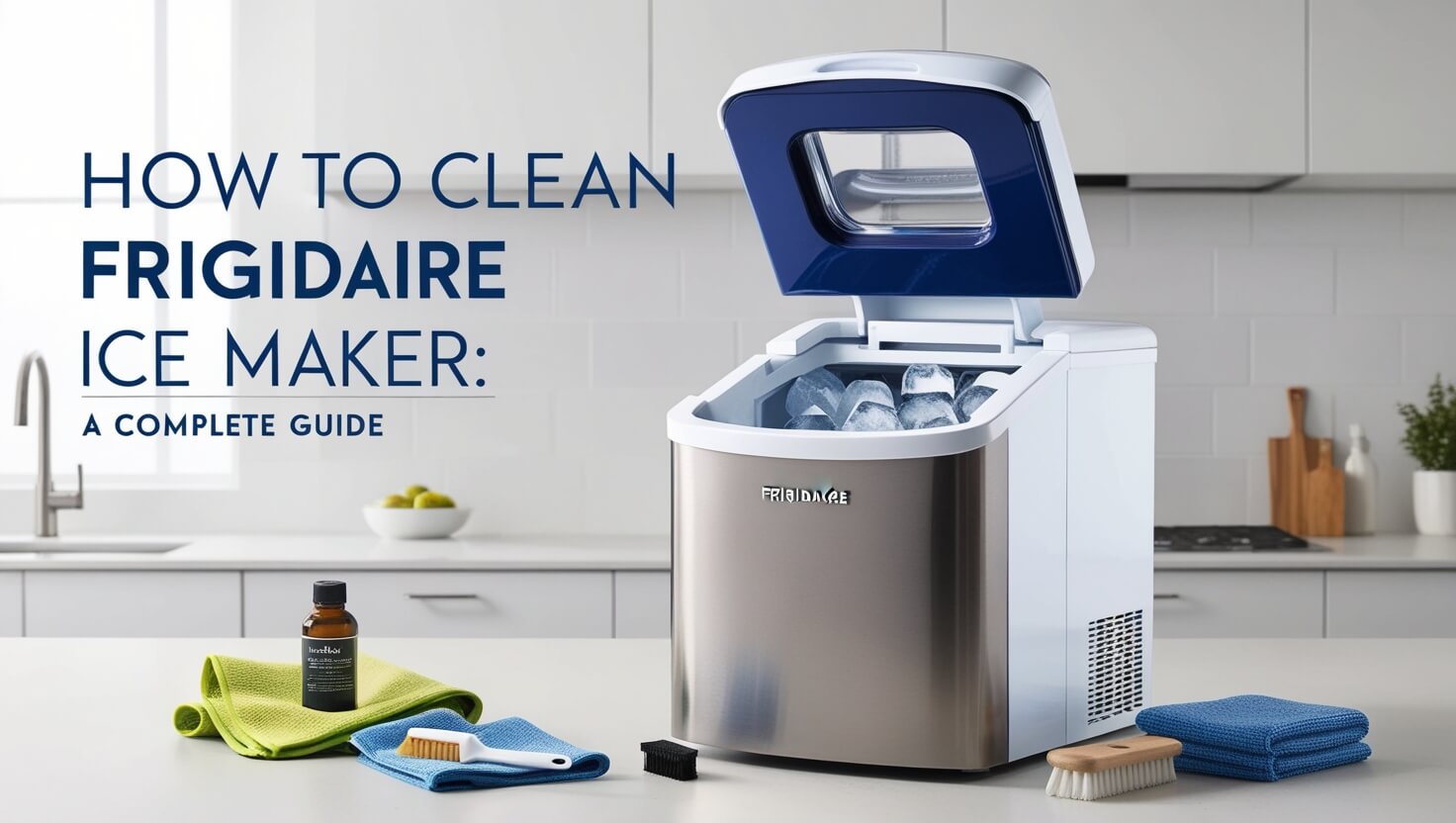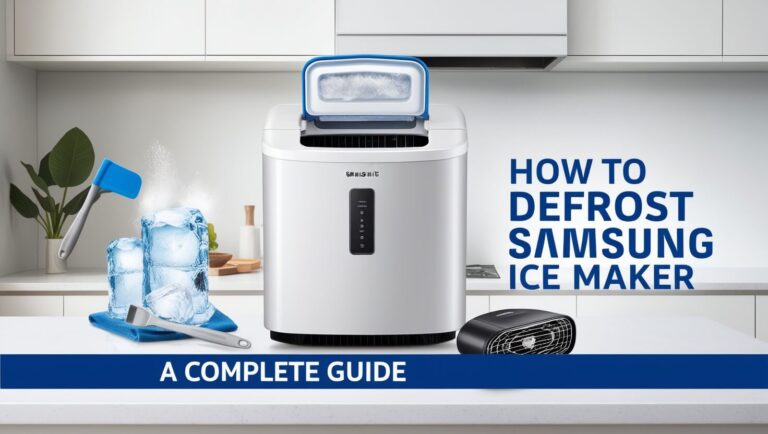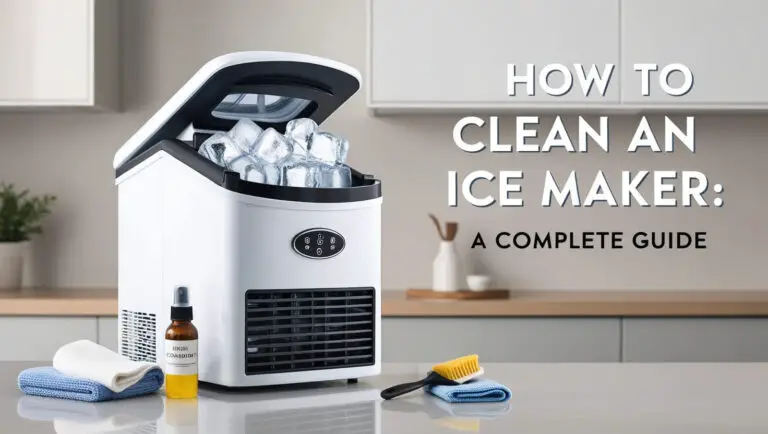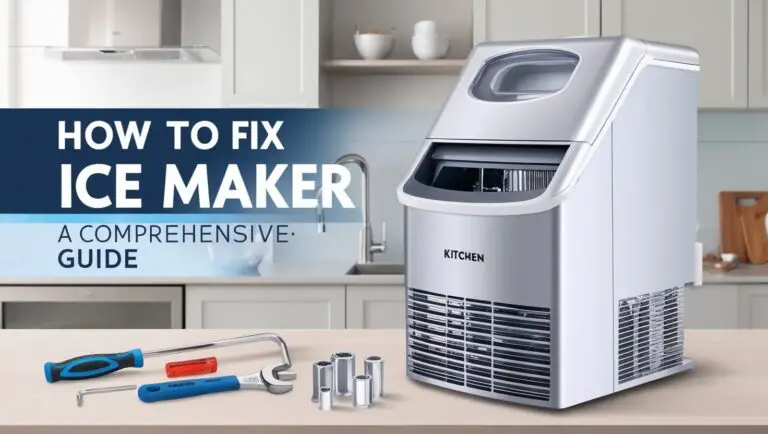How to Clean Frigidaire Ice Maker: A Complete Guide

Keeping your Frigidaire ice maker clean is crucial for producing fresh, great-tasting ice and ensuring the longevity of your appliance. In this comprehensive guide, we’ll walk you through the process of cleaning your Frigidaire ice maker, from basic maintenance to deep cleaning techniques. By following these steps, you’ll improve ice quality, prevent potential health issues, and keep your ice maker running smoothly for years to come.
Why Regular Cleaning is Crucial for Your Frigidaire Ice Maker
Regular cleaning of your Frigidaire ice maker isn’t just about aesthetics. It’s essential for several important reasons:
Health and Safety Concerns
Over time, ice makers can accumulate bacteria, mold, and other harmful microorganisms. These can contaminate your ice, potentially leading to health issues. Regular cleaning helps prevent the growth of these pathogens, ensuring that your ice is safe for consumption.
Improved Ice Quality and Taste
A clean ice maker produces better-tasting ice. Mineral deposits, food particles, and other contaminants can affect the flavor and appearance of your ice. By keeping your Frigidaire ice maker clean, you’ll enjoy crystal-clear, odor-free ice that enhances your beverages.
Extended Lifespan of Your Ice Maker
Regular cleaning helps prevent the buildup of mineral deposits and other debris that can damage your ice maker’s components. This maintenance can significantly extend the life of your appliance, saving you money on repairs or replacements in the long run.
Signs Your Frigidaire Ice Maker Needs Cleaning
Knowing when to clean your ice maker is just as important as knowing how. Here are some telltale signs that it’s time to give your Frigidaire ice maker some attention:
Visible Dirt and Grime
If you can see dirt, grime, or mineral buildup in your ice maker or on the ice itself, it’s definitely time for a cleaning. This buildup can affect both the taste of your ice and the efficiency of your machine.
Strange Odors or Tastes
If your ice has an unusual smell or taste, it’s likely that your ice maker needs cleaning. Odors can be caused by food particles, mold growth, or absorbed freezer smells.
Reduced Ice Production
A dirty ice maker may produce less ice than usual or take longer to make ice. This can be due to mineral buildup interfering with the freezing process or clogged water lines.
Unusual Noises
If your ice maker is making strange noises during operation, it could be a sign of debris interfering with the moving parts. A good cleaning might resolve the issue.
Gathering Necessary Supplies for Cleaning
Before you start cleaning your Frigidaire ice maker, it’s important to gather all the necessary supplies. Having everything on hand will make the process smoother and more efficient.
Safe Cleaning Products for Frigidaire Ice Makers
- White vinegar: A natural, food-safe cleaner that’s effective for removing mineral deposits
- Mild dish soap: For general cleaning
- Baking soda: Another natural cleaner that can help remove odors
- Sanitizing solution: A mixture of 1 tablespoon of bleach per gallon of water (for thorough sanitization)
Tools You’ll Need
- Soft cloths or microfiber towels
- Soft-bristled brush or old toothbrush
- Plastic scraper (for stubborn buildup)
- Bucket or large bowl
- Ice scoop
Protective Gear
- Rubber gloves
- Safety glasses (optional, but recommended when using cleaning solutions)
Step-by-Step Guide to Clean Your Frigidaire Ice Maker
Now that you’ve gathered your supplies, let’s walk through the cleaning process step by step:
Preparing Your Ice Maker for Cleaning
- Unplug the ice maker or turn off the power supply to ensure safety.
- Remove all ice from the bin and dispose of it.
- If possible, remove the ice bin from the unit for easier cleaning.
Removing and Cleaning the Ice Bin
- Wash the ice bin with warm, soapy water.
- Rinse thoroughly to remove all soap residue.
- For stubborn stains, create a paste with baking soda and water, apply it to the stains, let it sit for a few minutes, then scrub and rinse.
- Dry the bin completely with a clean towel.
Cleaning the Ice Maker’s Interior
- Wipe down all interior surfaces with a soft cloth dampened with a mixture of warm water and mild dish soap.
- Pay special attention to corners and crevices where grime can accumulate.
- For mineral deposits, use a solution of equal parts water and white vinegar.
- Use a soft-bristled brush to gently scrub any stubborn areas.
- Wipe all surfaces with a clean, damp cloth to remove any remaining cleaning solution.
Tackling the Water Line and Filter
- If your Frigidaire model has a removable water filter, replace it according to the manufacturer’s instructions.
- Clean the water line by disconnecting it and flushing it with a mixture of water and vinegar.
- Reconnect the water line securely.
Sanitizing the Ice Maker
- Prepare a sanitizing solution by mixing 1 tablespoon of bleach with 1 gallon of water.
- Use a cloth dampened with this solution to wipe down all interior surfaces.
- Let the solution sit for 5-10 minutes.
- Rinse all surfaces thoroughly with clean water to remove any bleach residue.
- Dry all surfaces completely with a clean towel.
Reassembling and Testing
- Replace the clean ice bin in the unit.
- Plug the ice maker back in or turn the power supply back on.
- Run through 2-3 ice-making cycles, discarding the ice each time to ensure any remaining cleaning solution is flushed out.
- Once you’re confident all cleaning residues are gone, your ice maker is ready for regular use.
Deep Cleaning Techniques for Stubborn Grime
Sometimes, your Frigidaire ice maker might need a more intensive cleaning. Here are some techniques for tackling tough cleaning challenges:
Using Vinegar Solution for Mineral Deposits
If you live in an area with hard water, mineral deposits can be a persistent problem. Here’s how to address them:
- Create a solution of equal parts water and white vinegar.
- Turn off the ice maker and remove all ice.
- Pour the solution into the water reservoir.
- Run the ice maker through 2-3 cycles, discarding the ice each time.
- Drain any remaining solution and rinse the system thoroughly with clean water.
- Run several more cycles with clean water, discarding the ice until there’s no vinegar taste or smell.
Tackling Mold and Mildew
Mold and mildew can be health hazards and affect the taste of your ice. Here’s how to deal with them:
- Mix a solution of 1 tablespoon of baking soda in 1 quart of warm water.
- Use this solution to scrub any visible mold or mildew with a soft brush.
- Rinse thoroughly and dry completely.
- For persistent mold, you may need to use a stronger sanitizing solution (like the bleach solution mentioned earlier), following up with thorough rinsing.
Dealing with Tough Stains
For stubborn stains that won’t come off with regular cleaning:
- Create a paste with baking soda and a small amount of water.
- Apply the paste to the stained areas and let it sit for 10-15 minutes.
- Scrub gently with a soft brush.
- Rinse thoroughly and dry.
Maintenance Tips to Keep Your Frigidaire Ice Maker Clean
Prevention is always better than cure. Here are some tips to keep your ice maker clean between deep cleanings:
Regular Cleaning Schedule
Set a schedule for regular cleaning. Depending on usage, aim to deep clean your ice maker every 3-6 months.
Quick Daily Wipe-downs
Make it a habit to wipe down the exterior and easily accessible interior parts of your ice maker daily or every few days. This prevents buildup and makes deep cleaning easier.
Proper Usage Habits
- Always use clean hands or a clean scoop when handling ice.
- Keep the ice maker door closed when not in use to prevent dust and debris from entering.
- If you won’t be using the ice maker for an extended period, empty it completely and leave the door open to prevent mold growth.
Troubleshooting Common Cleaning Issues
Even with careful cleaning, you might encounter some issues. Here’s how to troubleshoot common problems:
Ice Maker Not Working After Cleaning
If your ice maker isn’t functioning properly after cleaning:
- Check that it’s plugged in and turned on.
- Ensure the water line is connected properly and not kinked.
- Verify that the freezer temperature is cold enough (0°F or -18°C).
- Give it some time – it may take a while to start producing ice again after cleaning.
Lingering Odors
If odors persist after cleaning:
- Try placing an open box of baking soda in the ice bin for 24 hours to absorb odors.
- Clean again, paying special attention to corners and crevices where odor-causing bacteria might hide.
- Consider replacing the water filter if your model has one.
Water Leaks During Cleaning
If you notice water leaking during the cleaning process:
- Check all connections to ensure they’re tight.
- Inspect hoses for any cracks or damage.
- Make sure you haven’t overfilled any reservoirs during cleaning.
- If leaks persist, you may need to call a professional to check for internal issues.
Dos and Don’ts of Cleaning Frigidaire Ice Makers
To ensure you’re cleaning your ice maker effectively and safely, keep these dos and don’ts in mind:
Safe Cleaning Practices
Do:
- Use food-safe cleaning products.
- Unplug the ice maker before cleaning.
- Dry all parts thoroughly before reassembling.
- Replace water filters regularly.
- Follow manufacturer’s instructions for your specific model.
Common Mistakes to Avoid
Don’t:
- Use abrasive cleaners or scouring pads that can scratch surfaces.
- Submerge electrical components in water.
- Forget to rinse thoroughly after using cleaning solutions.
- Ignore small issues – they can become bigger problems over time.
- Use hot water to clean ice maker components, as it can warp plastic parts.
When to Seek Professional Help
While regular cleaning and maintenance can solve most issues, there are times when professional help might be necessary:
Signs of Serious Issues
Consider calling a professional if:
- You notice persistent unusual noises or vibrations.
- The ice maker consistently underperforms despite regular cleaning.
- There are signs of electrical issues (sparks, burning smell, etc.).
- You see evidence of a refrigerant leak.
Finding Qualified Technicians
To find a qualified technician:
- Check if your ice maker is still under warranty and contact the manufacturer.
- Look for technicians certified by the manufacturer or with relevant certifications (e.g., EPA 608 certification for handling refrigerants).
- Read reviews and ask for recommendations from friends or family.
- Get multiple quotes before deciding on a service.
Comparing DIY Cleaning vs. Professional Services
Deciding between DIY cleaning and professional services depends on several factors:
Cost Considerations
DIY cleaning is generally more cost-effective for routine maintenance. However, if you’re dealing with complex issues or don’t have the time, professional services might be worth the investment.
Time and Effort
DIY cleaning takes time and effort but gives you control over the process. Professional services save time but require scheduling and potentially having someone in your home.
Effectiveness and Results
While DIY cleaning can be very effective for routine maintenance, professionals have specialized tools and knowledge that might be necessary for more complex issues.
Closing Thoughts
Cleaning your Frigidaire ice maker is an essential part of maintaining this convenient appliance. Regular cleaning not only ensures that you have a steady supply of fresh, clean ice but also extends the life of your ice maker.
By following the steps outlined in this guide, you can keep your Frigidaire ice maker in top condition. Remember to clean it regularly, be attentive to signs that it needs cleaning, and don’t hesitate to seek professional help for more complex issues.
With proper care and maintenance, your Frigidaire ice maker will continue to provide you with clean, fresh ice for years to come. So, roll up your sleeves, gather your cleaning supplies, and give your ice maker the attention it deserves. Your future self (and your beverages) will thank you!






